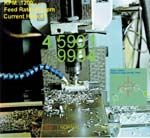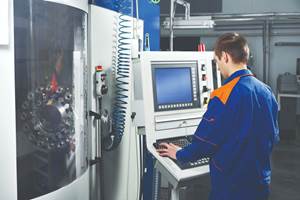The DRO You Wear
Dubbed iPRO for interactive personal readout, this DRO system is wearable, wireless and voice activated. Each of these features is remarkable in its own right. Combined, however, they make the most futuristic DRO system you are likely to encounter.
According to Danny Donaldson, president of Newall Electronics, Inc., (Columbus, Ohio), his company was determined to find the most innovative and advanced personal computer technology and combine it with the best that a digital readout has to offer in a machine shop setting, thereby leapfrogging current DRO developments. "We wanted to see how far we could go to create the most innovative man/machine interface in existence," Mr. Donaldson explains.
The results were on display at EASTEC, New England's big metalworking technology show in May.
Dubbed iPRO for interactive personal readout, the system is wearable, wireless and voice activated. Each of these features is remarkable in its own right. Combined, however, they make the most futuristic DRO system you are likely to encounter today.
Despite the startlingly different appearance of the iPRO headgear and belt-mounted PC, the system is based on a fundamental principle: anything that distracts the skilled machinist from the work is likely to hinder productivity. With a wireless, voice activated DRO, the machinist can view axis position and other machine parameters without looking at an out-of-the-way pendant-mounted display panel. Likewise, spoken commands replace keystrokes to activate DRO functions and call up other PC applications.
On the PC side, the system employs a Xybernaut MA IV wearable PC. The wireless processor unit is attached to a belt and worn around the waist. A lightweight display unit fits on the head like a set of earphones, with speaker mike and eye-level projection screen. Although the projection screen is half the size of a plastic credit card, special optics make the projected image appear to be virtually as large and as clear as the image visible on a 15-inch color monitor. Made of semi-transparent material, the screen does not obscure objects seen through it. Thus, numbers and images seem to float in space, much like the effect shown in the photo on this page.
The processor on the belt runs the Windows operating system on a Pentium MMX 233 MHz platform. Using a wireless LAN, the system can link to the Internet or an intranet to download CAD data, read e-mail or access other databases. Rechargeable batteries that last about 4 hours power the unit. Batteries can be replaced without disrupting operation. The voice activation feature allows the user to "teach" the system to recognize a set of command words and phrases for hands-free operation.
As for the DRO, it is a fully functioning system that includes bolt-hole circle routines, programmable memory, arc contouring, polar coordinate readings and line hole routines. User definable subroutines can be added to include spindle speed, feed rate, chip load and speed/feed charts.
Each linear encoder on the machine's axes is cabled to a transmitter that sends its positional data via a license-free radio frequency link to receivers in the PC processor unit. Thus, the wearer can walk freely around the machine and still view readout displays. The iPRO will accept as many as 12 encoders per machine. Where multiple machines are equipped with DRO transmitters, the system can be configured so that a unique code can be used to select which machine's readout data to receive and display. According to developers, the range of the transmitters is several hundred meters.
Currently, an iPRO system is priced in the $10,000 range, but as wearable, wireless systems proliferate, Mr. Donaldson expects prices to fall and new features to be added. He expects the high-tech appeal of the wireless technology to be especially attractive to younger users who are familiar with PC technology and are eager to be part of innovative applications, "We've proven the concept by being first to market with a viable system," Mr. Donaldson says. "I think we'll find that the market is ready for this level of innovation as well."
Related Content
Generating a Digital Twin in the CNC
New control technology captures critical data about a machining process and uses it to create a 3D graphical representation of the finished workpiece. This new type of digital twin helps relate machining results to machine performance, leading to better decisions on the shop floor.
Read MoreUnderstanding CNC Machine Accuracy and Repeatability
Properly evaluating machine tool capability requires understanding how the both user and the builder can influence precision.
Read More5 G-Code Tips for Increasing CNC Efficiency
Optimizing G code is a low-cost way to improve CNC efficiency without sacrificing usability and safety.
Read MoreHow this Job Shop Grew Capacity Without Expanding Footprint
This shop relies on digital solutions to grow their manufacturing business. With this approach, W.A. Pfeiffer has achieved seamless end-to-end connectivity, shorter lead times and increased throughput.
Read MoreRead Next
3 Mistakes That Cause CNC Programs to Fail
Despite enhancements to manufacturing technology, there are still issues today that can cause programs to fail. These failures can cause lost time, scrapped parts, damaged machines and even injured operators.
Read MoreThe Cut Scene: The Finer Details of Large-Format Machining
Small details and features can have an outsized impact on large parts, such as Barbco’s collapsible utility drill head.
Read More













.png;maxWidth=300;quality=90)
.png;maxWidth=300;quality=90)













